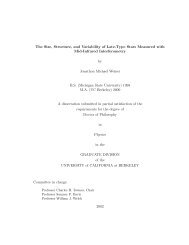Astro 160: The Physics of Stars
Astro 160: The Physics of Stars
Astro 160: The Physics of Stars
Create successful ePaper yourself
Turn your PDF publications into a flip-book with our unique Google optimized e-Paper software.
we can now see the collision times for the electron-electron collision occurs more rapidly due to themass being so much smaller.t e ≪ t p(c). Which opacity is more important for photons, Thomson scattering or free-free absorption?We know thatandκ T = n eσ Tρ c= 2σ Tm p∼ 0.80κ F = 10 23 ρT −7/2 ∼ 1.15free-free absorption dominates the opacity for photons in this case? not sure why this is. We know thatThomson scattering is the primary way that photons move the energy out.(d). What is the mean free path <strong>of</strong> a photon? How does this compare to the mean free path <strong>of</strong> anelectron (this should give you a feel for why photons are far more effective at moving energy around instars)? What is the typical time between photon absorptions/scattering?we know that the mean free path <strong>of</strong> a photon is given byl = 1 where σ T = 8π [e 2 ] 2n e σ T 3 4πε 0 m e c 2 = 6.65 × 10 −25 cm 2which yieldsl photon = m p∼ 8.3 × 10 −3 cm2ρσ Tl electron = m pρ c π<strong>The</strong> typical time for a photon collision is given by( kTe 2 ) 2∼ 8.9 × 10 −7 cmt = l pc ∼ 2.8 × 10−13 s(e). For a photon undergoing a random walk because absorption/scattering, how long would it take tomove a distance R sun given the results in (d)? For comparison, it would take 2.3 seconds moving at thespeed <strong>of</strong> light to travel a distance R sun in the absence <strong>of</strong> scattering/absorption.We know that the diffusion time can be acquired witht di f f =thermal energyL∼ R2 nkTlc aT 4 ∼ R2 nklcaT 3 ∼we know that the average time for a photon to leave the star is given byt di f f ∼ R2 sunl ph c ∼ 104 yr4R2 2ρkm p lcaT 3












![Problem #1 [Structure Formation I: Radiation Era]](https://img.yumpu.com/37147371/1/190x245/problem-1-structure-formation-i-radiation-era.jpg?quality=85)



